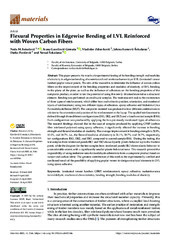Приказ основних података о документу
Flexural Properties in Edgewise Bending of LVL Reinforced with Woven Carbon Fibers
| dc.creator | Sokolović, Neda M. | |
| dc.creator | Gavrilović-Grmuša, Ivana | |
| dc.creator | Zdravković, Vladislav | |
| dc.creator | Ivanović-Šekularac, Jelena A. | |
| dc.creator | Pavićević, Darko | |
| dc.creator | Šekularac, Nenad | |
| dc.date.accessioned | 2023-12-05T13:17:31Z | |
| dc.date.available | 2023-12-05T13:17:31Z | |
| dc.date.issued | 2023 | |
| dc.identifier.issn | 1996-1944 | |
| dc.identifier.uri | https://raf.arh.bg.ac.rs/handle/123456789/1790 | |
| dc.description.abstract | This paper presents the results of experimental testing of the bending strength and modulus of elasticity in edgewise bending of unreinforced and reinforced seven-layer LVL (laminated veneer lumber) poplar veneer panels. The aim of the research is to determine the influence of woven carbon fibers on the improvement of the bending properties and modulus of elasticity of LVL bending in the plane of the plate, as well as the influence of adhesives on the bending properties of the composite product, in order to test the potential of using this newly obtained material as a structural element. Bending was performed on small-scale samples. The main research task is the examination of three types of reinforcement, which differ from each other in position, orientation, and number of layers of reinforcement, using two different types of adhesives: epoxy adhesive and Melamine Urea Formaldehyde Resins (MUF). The composite material was produced in four different combinations in relation to the orientation and position of the reinforcement in the layup. The applied reinforcement is defined through three different configurations (EK1, EK2, and EK3) and a fourth control sample (EK4). Each configuration was produced by applying the two previously mentioned types of adhesives. The research findings showed that in the case of samples produced by applying CFRP (carbon fiber reinforced polymer) using epoxy adhesive, it significantly affected the increase in bending strength and flexural modulus of elasticity. The average improvement in bending strength is 32.9%, 33.2%, and 38.7%, i.e., the flexural modulus of elasticity is 54.1%, 50.7%, and 54.7%, respectively, for configurations EK1, EK2, and EK3, compared to control sample EK4. During the testing, the test samples from reinforced panels EK1 and EK2 showed partly plastic behavior up to the fracture point, while the diagram for the test samples from reinforced panels EK3 shows elastic behavior to a considerable extent, with a significantly smaller plastic behavior zone. This research proved the impossibility of using melamine-urea formaldehyde adhesive to form a composite product based on veneer and carbon fabric. The greatest contribution of this work is the experimentally verified and confirmed result of the possibility of applying poplar veneer to design structural elements in LVL using epoxy adhesive. | sr |
| dc.language.iso | en | sr |
| dc.publisher | Basel : MDPI | sr |
| dc.relation | MPTR Srbije 2023 Istraživačka laboratorija - Laboratorija arhitektonskog prostora - forma, funkcija i materijalizacija | sr |
| dc.rights | openAccess | sr |
| dc.rights.uri | https://creativecommons.org/licenses/by/4.0/ | |
| dc.source | Materials | sr |
| dc.subject | laminated veneer lumber | sr |
| dc.subject | CFRP | sr |
| dc.subject | reinforcement | sr |
| dc.subject | epoxy adhesive | sr |
| dc.subject | melamine-urea formaldehyde | sr |
| dc.subject | mechanical characteristics | sr |
| dc.subject | bending strength | sr |
| dc.subject | bending modulus of elasticity | sr |
| dc.title | Flexural Properties in Edgewise Bending of LVL Reinforced with Woven Carbon Fibers | sr |
| dc.type | article | sr |
| dc.rights.license | BY | sr |
| dcterms.abstract | Ивановић-Шекуларац, Јелена A.; Гавриловић-Грмуша, Ивана; Павићевић, Дарко; Шекуларац, Ненад; Здравковић, Владислав; Соколовић, Неда М.; | |
| dc.citation.volume | 16 | |
| dc.citation.issue | 9 | |
| dc.citation.spage | 3346 | |
| dc.description.other | Special Issue New Advances in Strengthening of Structural Timber | sr |
| dc.identifier.doi | 10.3390/ma16093346 | |
| dc.identifier.fulltext | http://raf.arh.bg.ac.rs/bitstream/id/6161/materials-16-03346-v2.pdf | |
| dc.type.version | publishedVersion | sr |

